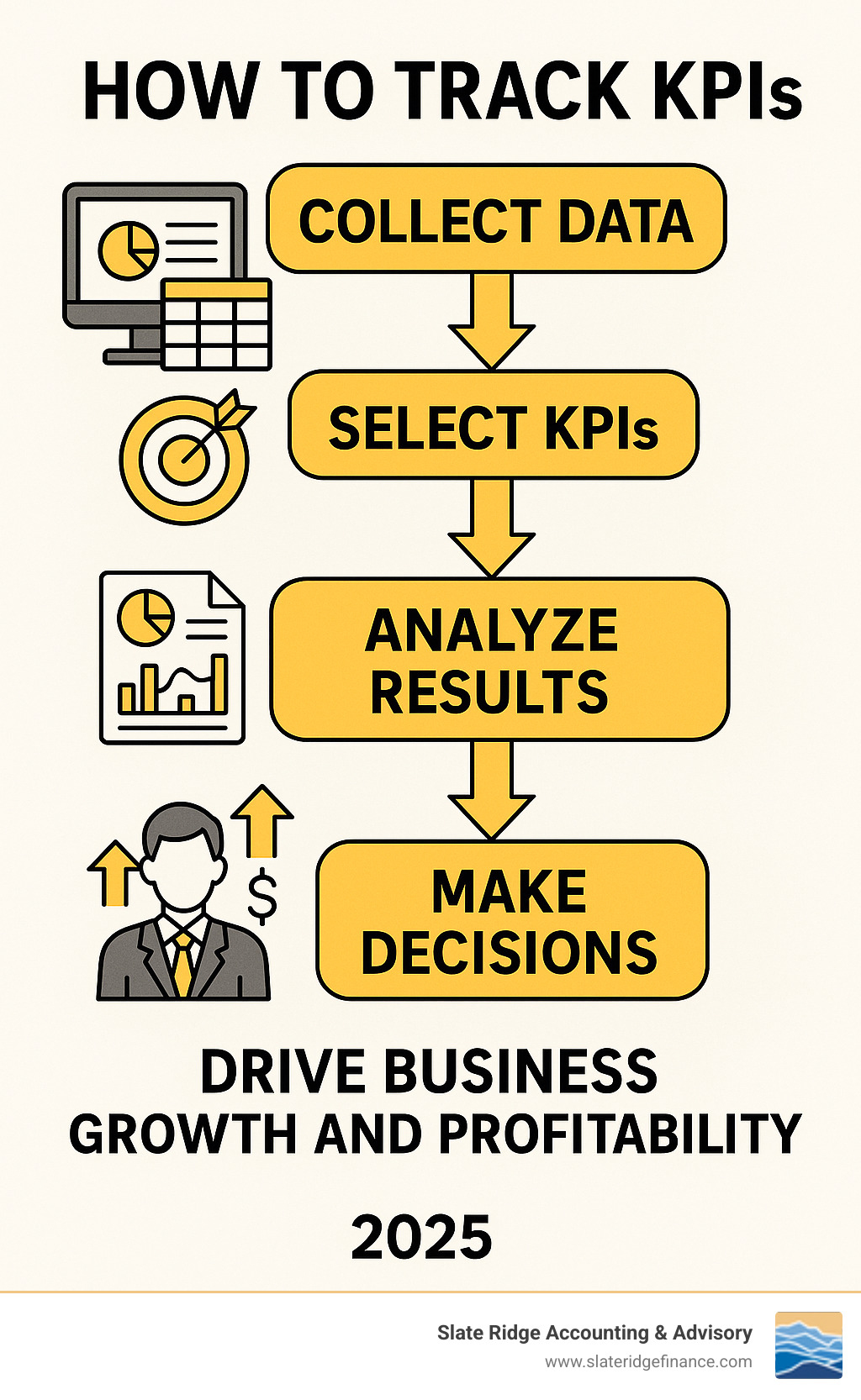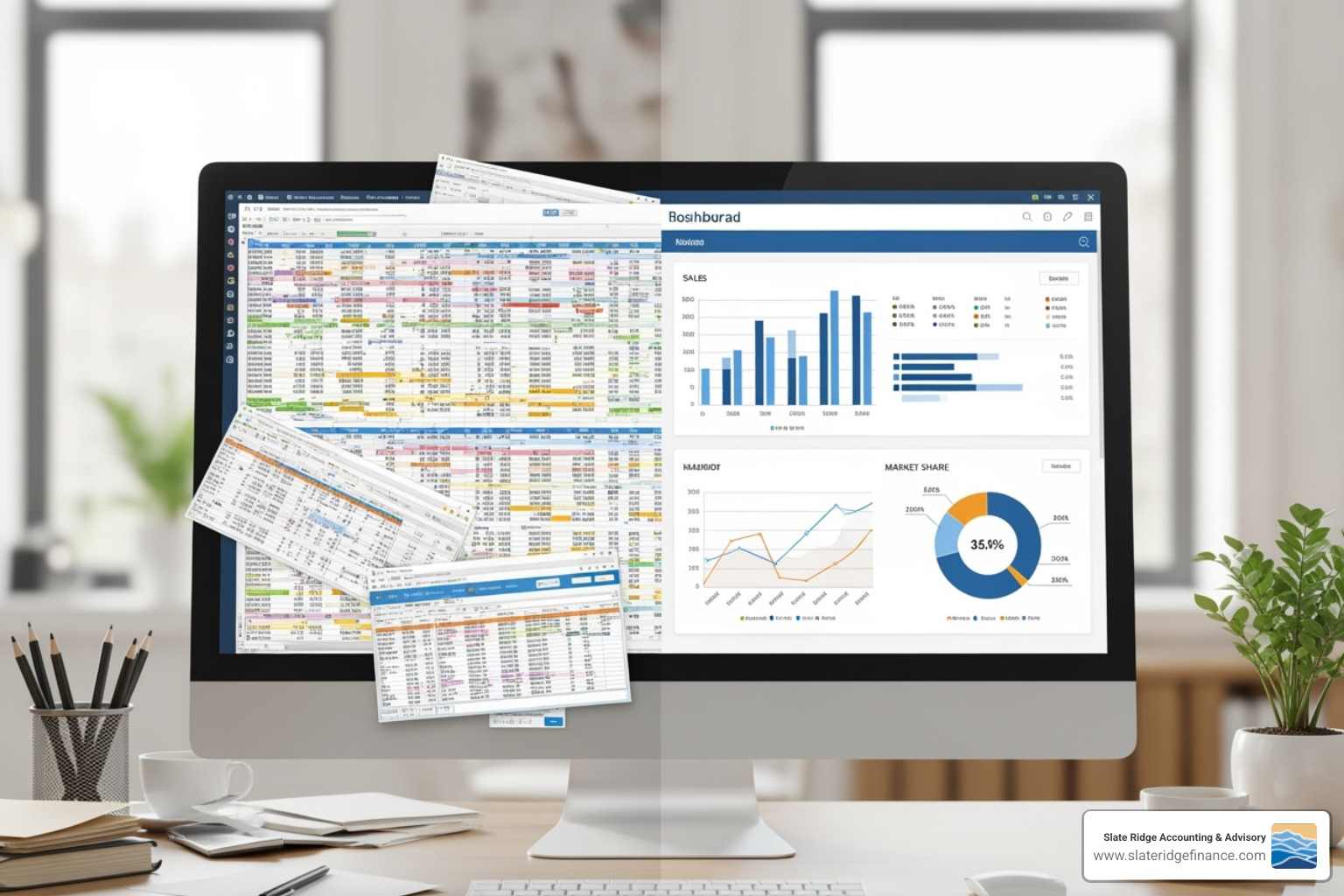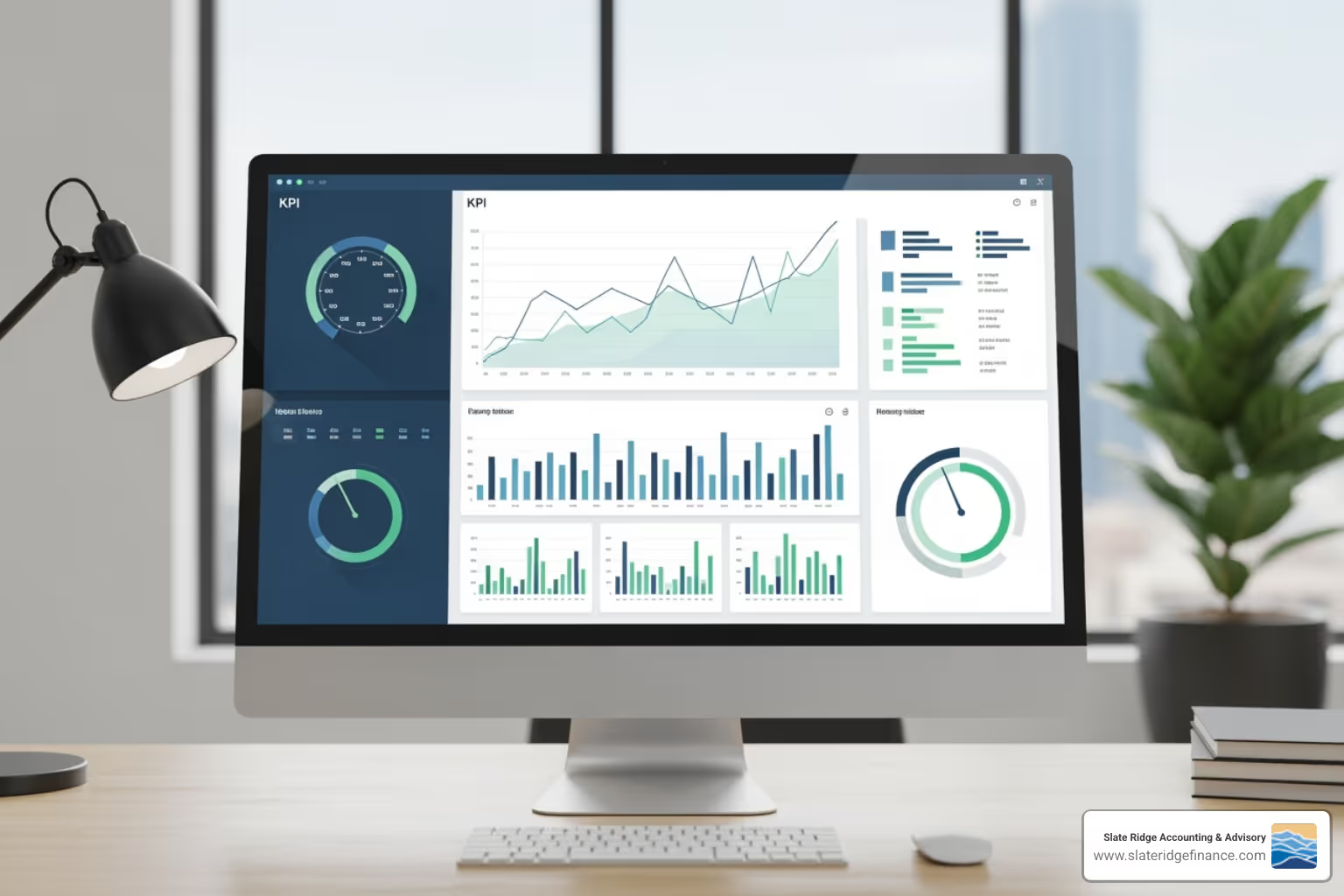Why Tracking KPIs is Your Business Game-Changer
How to track KPIs effectively starts with understanding what matters most to your business. Here's the essential process:
- Define your strategic business objectives - Know what success looks like
- Select 5-10 relevant KPIs - Focus on metrics that directly impact your goals
- Set up a tracking system - Use spreadsheets, accounting software, or KPI dashboards
- Review and analyze regularly - Weekly for operational KPIs, monthly for strategic ones
- Take action on insights - Adjust strategies based on what the data tells you
Many small business owners are drowning in data but starving for insights. Spreadsheets overflow with numbers, but the key to faster growth feels buried.
The truth is simple: companies that monitor KPIs are far more likely to achieve profitable growth. The problem is that most businesses track too many meaningless metrics or focus on vanity numbers that don't drive real decisions.
KPIs are your business compass, pointing you toward your goals. Done right, they transform overwhelming data into clear, actionable steps that drive real results.
The difference between businesses that thrive and those that simply survive often comes down to one thing: knowing which numbers matter and acting on them consistently.

Understanding the Fundamentals: KPIs vs. Metrics
Before diving into the practical steps of how to track KPIs, let's clarify what they are. Many business owners get overwhelmed by tracking everything instead of focusing on what truly matters.
Think of metrics as all the gauges in a car. KPIs are the specific indicators—like the GPS—that tell you if you're reaching your destination. This distinction is key for effective Business Growth Strategies.
What Are Key Performance Indicators (KPIs)?
A Key Performance Indicator is a measurable value showing how effectively you're achieving key business objectives. It connects daily activities to your big-picture goals, answering the question: "Are we making progress or just staying busy?"
When you're gauging success through performance evaluation, KPIs provide that "aha!" moment where scattered data suddenly makes sense.
The Critical Difference Between a KPI and a Metric
This is where many businesses go wrong. The difference seems small, but its strategic impact is huge.
Metrics are general measurements, like website visitors or total sales. They describe what happened but don't judge if it was good or bad.
KPIs are goal-oriented; they measure progress toward a specific objective. Instead of just "website visitors," a KPI might be "conversion rate from visitors to customers" if your goal is growing sales.
A common trap is focusing on vanity metrics—numbers that look impressive but don't help with strategic decisions. Having a million social media followers is great, but not if they don't buy from you.
The Anatomy of a Powerful KPI: The SMART Framework
The best KPIs follow the SMART framework. This is a practical filter that separates useful KPIs from wishful thinking.
- Specific: Be crystal clear. Instead of "improve customer service," use "reduce average email response time to 4 hours."
- Measurable: You must be able to track it with real numbers.
- Achievable: Set challenging but realistic targets to avoid demoralizing your team.
- Relevant: Ensure the KPI directly connects to a core business objective.
- Time-bound: Set clear deadlines. "Someday" doesn't drive action.
This approach, detailed in A guide to SMART goals, transforms goals into actionable performance measurement.
Key Types of KPIs to Know
Different types of KPIs help you build a complete picture of your business performance.
- Quantitative indicators are hard numbers (revenue, costs), while qualitative indicators measure softer aspects (customer satisfaction, brand reputation).
- The real power comes from understanding leading vs. lagging indicators. Leading indicators (e.g., qualified leads) predict future outcomes, while lagging indicators (e.g., last month's revenue) report on the past.
- You also have Input KPIs (resources used, like marketing spend) and Output KPIs (results achieved, like products sold).
Connecting these types gives you a roadmap for how to track KPIs that actually improve your business performance.
A Step-by-Step Guide on How to Track KPIs Effectively
Now that we understand the fundamentals, let's get into the actionable steps for how to track KPIs effectively. This systematic approach ensures our efforts translate into tangible insights and improved performance.
Step 1: Define Your Strategic Business Objectives
Before choosing metrics, you must clearly define what success means for your business. Align your KPI efforts with your company mission and strategic plan. Ask yourself:
- What are our main goals for the next quarter or year?
- What does achieving these goals look like?
- Who are the key stakeholders, and what do they need to know?
This foundational step provides context and ensures every KPI serves a clear purpose.
Step 2: Select the Right KPIs for Your Business
The goal isn't to track every metric. Information overload can hide clear results and lead to inaction. A well-structured plan typically uses between five and ten key metrics to gauge performance.
When selecting KPIs, aim for those that are:
- Actionable: Can you influence this number through your efforts?
- Relevant: Does it directly impact your defined business objectives?
- Balanced: Do you have a mix of financial, non-financial, leading, and lagging indicators?
Focus on the KPIs that give you early confirmation of success or alert you to potential problems.
Step 3: Establish a System for How to Track KPIs
Once your KPIs are defined, you need a reliable system to collect and present the data. While spreadsheets can be a starting point, they are often manual and prone to errors as a business grows.

Modern solutions offer far greater efficiency:
- Accounting Software & Cloud Services: For financial KPIs, our Cloud Accounting Services can automatically track and report on crucial metrics.
- Dedicated KPI Tracking Software & Dashboards: These tools automate data collection, visualize KPIs in easy-to-understand charts, and provide real-time updates. They offer a single source of truth for performance management.
The key is choosing a system that fits your business's size and budget while ensuring data quality and consistency.
Step 4: Analyze and Act on Your KPI Data
Tracking KPIs is only half the battle. The real value comes from analyzing the data and taking informed action. Establish a regular review schedule—weekly for operational KPIs, monthly or quarterly for strategic ones.
During these reviews, look for:
- Trends and Patterns: Are your KPIs moving in the right direction?
- Anomalies and Deviations: Are there sudden drops or spikes that require investigation?
- Opportunities and Challenges: What insights can help you solve issues or capitalize on opportunities?
The purpose of KPI analysis is to understand why the numbers are what they are. Use this understanding to make data-based decisions, adjust strategies, and optimize performance. The value of KPIs lies in the actions they inspire.
Essential KPIs for Every Small Business Department
Now that we understand how to track KPIs systematically, let's explore specific indicators for different areas of your business. While your exact KPIs will depend on your industry and goals, these metrics provide a solid starting point for your performance measurement system.

Financial KPIs
Your financial health is the heartbeat of your business. These KPIs offer a clear picture of profitability and stability. Mastering them through services like our Accounts for Small Business is about making smart decisions that drive growth.
- Net Profit Margin: Shows the percentage of revenue left after all expenses. It's the ultimate measure of profitability.
- Gross Margin: Measures revenue minus the direct costs of your product/service. It shows if you have enough cushion to cover operating expenses.
- Operating Cash Flow: Measures the cash generated from normal operations. It's critical for sustainability and growth investment.
- Accounts Receivable Turnover: Reveals how quickly you collect customer payments, which is vital for cash flow.
Sales & Marketing KPIs
These metrics tell the story of how effectively you're attracting customers and if your marketing dollars are paying off.
- Customer Acquisition Cost (CAC): The total cost to acquire one new customer. It must be lower than the customer's lifetime value.
- Customer Lifetime Value (CLV): The total revenue you expect from a single customer. It helps determine how much you can afford to spend on acquisition.
- Lead Conversion Rate: The percentage of leads who become customers. It reveals the effectiveness of your sales process.
- Return on Marketing Investment (ROMI): Shows the revenue generated for every dollar spent on marketing, proving its effectiveness.
Customer Service KPIs
Happy customers are your best marketing asset. These KPIs help you measure and improve their experience.
- Customer Satisfaction (CSAT): A direct measure of whether you're meeting customer expectations, usually from surveys.
- Net Promoter Score (NPS): Asks how likely customers are to recommend you, revealing loyalty and identifying brand advocates.
- First Response Time: Measures how quickly your team responds to inquiries. Faster times often correlate with higher satisfaction.
- Customer Retention Rate: The percentage of customers you keep over time. Retaining customers is more cost-effective than acquiring new ones.
Human Resources (HR) KPIs
Your team is your engine. These HR KPIs help you attract, develop, and retain the right people.
- Employee Turnover Rate: The percentage of employees who leave. High turnover is costly and can signal cultural issues.
- Time to Fill: Tracks how long it takes to hire for an open position. According to data on hiring timelines, long vacancies strain the team and can mean lost revenue.
- Employee Engagement: Measures team motivation and commitment. Engaged employees are more productive and less likely to leave.
- Training ROI: Helps determine if your investment in employee development is improving productivity, retention, or revenue.
Advanced KPI Strategies and Common Pitfalls
Once you've mastered the basics of how to track KPIs, it's time to explore advanced tools and strategies. But even seasoned business owners can fall into common traps.
The Power of KPI Dashboards and Reporting
KPI dashboards are your business's mission control, making important data visible at a glance so you can spot problems before they become disasters.
Real-time monitoring alerts you to issues immediately, not at month-end. Data visualization turns numbers into clear trend lines and charts, making insights easy to grasp. This leads to improved team communication, as everyone works from the same data, and better performance management, fostering accountability and motivation.
Common Challenges in KPI Tracking (And How to Overcome Them)
Even with the best intentions, tracking KPIs can go sideways. The good news is these common challenges are all fixable.
- Poor data quality: Garbage in, garbage out. Inaccurate data leads to bad decisions. The fix is automation and regular data audits. As we note in 3 Bookkeeping Myths That Could Be Costing You Money, clean data is crucial.
- Lack of team buy-in: If your team sees KPIs as a top-down mandate, they'll resist. Involve them in selecting metrics and explain how the data helps them succeed.
- Tracking too many metrics: This causes analysis paralysis. Stick to 5-10 critical KPIs that directly impact strategic goals.
- Setting unrealistic targets: Impossible goals demoralize teams. Base targets on historical data, industry benchmarks, and available resources.
KPIs vs. OKRs: Understanding the Difference
You've probably heard about OKRs (Objectives and Key Results). Both are valuable, but they serve different purposes.
KPIs measure the ongoing health of existing processes (e.g., customer retention rate). They are continuous and track the health of your business operations.
OKRs set ambitious, time-bound goals for change (e.g., "Launch a new service line"). They are typically set quarterly and push you beyond your current performance.
Think of KPIs as your business vital signs and OKRs as your fitness goals. You need both to stay healthy and grow stronger. The most successful businesses use both frameworks together.
Frequently Asked Questions about How to Track KPIs
It's natural to have questions when you're diving into something as impactful as how to track KPIs. Here are some answers to common curiosities.
How many KPIs should a small business track?
There's no magic number, but a great starting point is 5-10 key KPIs. This focuses on quality over quantity and helps you avoid "analysis paralysis." Focus on the indicators that directly align with your strategic objectives. You can always add more later as your business evolves.
How often should I review my KPIs?
The ideal frequency depends on the KPI. Operational KPIs, which relate to day-to-day activities, should be reviewed frequently, perhaps daily or weekly. Strategic KPIs, which reflect long-term goals, are better reviewed monthly or quarterly. The most important thing is to establish a regular, consistent review schedule that fits your business cycle.
Can I track KPIs without expensive software?
Yes, you can certainly start with spreadsheets like Excel or Google Sheets. They are accessible and work for basic tracking. However, manual tracking is time-consuming and prone to human error, making it difficult to scale.
As you grow, dedicated KPI tracking software or integrated accounting platforms offer huge advantages. They automate data collection, provide real-time insights, visualize data in clear dashboards, and improve data consistency. Investing in the right tools helps you Grow Your Small Business more efficiently by freeing up your valuable time for strategic thinking.
Conclusion: Turn Your Insights into Action
We've unpacked how to track KPIs, from understanding what they are to putting them into action. Mastering your Key Performance Indicators isn't just about crunching numbers; it's about turning raw data into powerful insights that drive your business forward.
Remember the cycle: define your objectives, select the right KPIs, establish a tracking system, and analyze the data to act on the insights. This data-driven culture empowers your team, leading to informed decisions, optimized performance, and sustainable strategic growth. It makes your business more resilient, efficient, and profitable.
This process can feel overwhelming, especially when you're busy running your business. That's where we come in. At Slate Ridge Accounting & Advisory, we specialize in simplifying financial data, helping you track KPIs and confidently forecast your next steps for growth. Our modern, personalized solutions mean you're never just looking at numbers; you're seeing your future.
Ready to stop drowning in data and start swimming in insights? Get expert help with your virtual accounting today and let's turn those insights into real action, together!
Ready to get started?
Book a free consultation today and let’s explore how Slate Ridge can support your business with expert accounting that’s accurate, timely, and built around your goals.




_compressed.jpeg)

